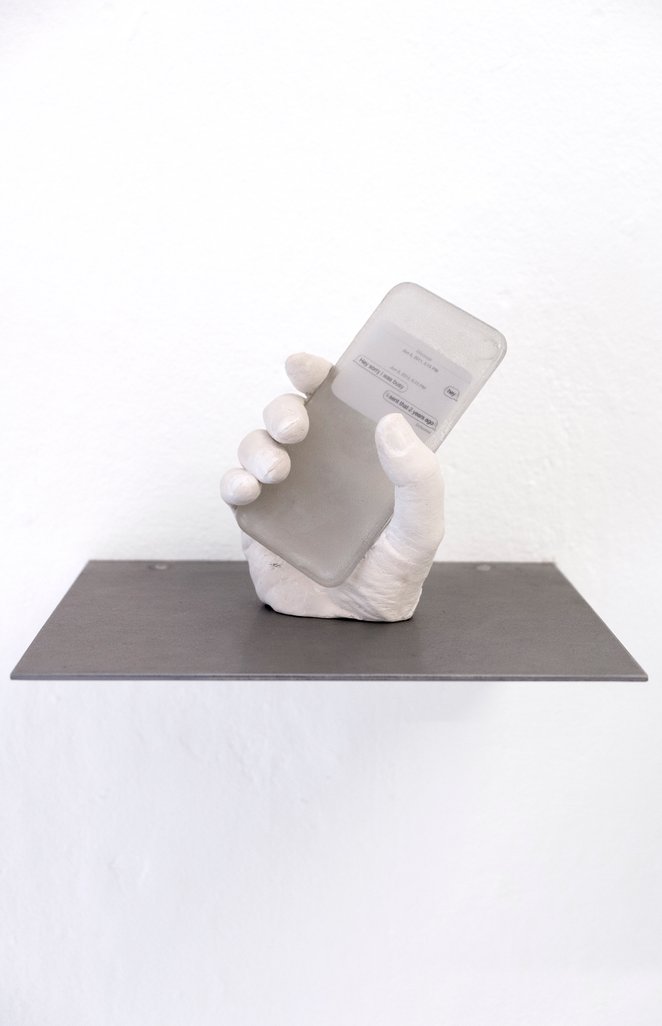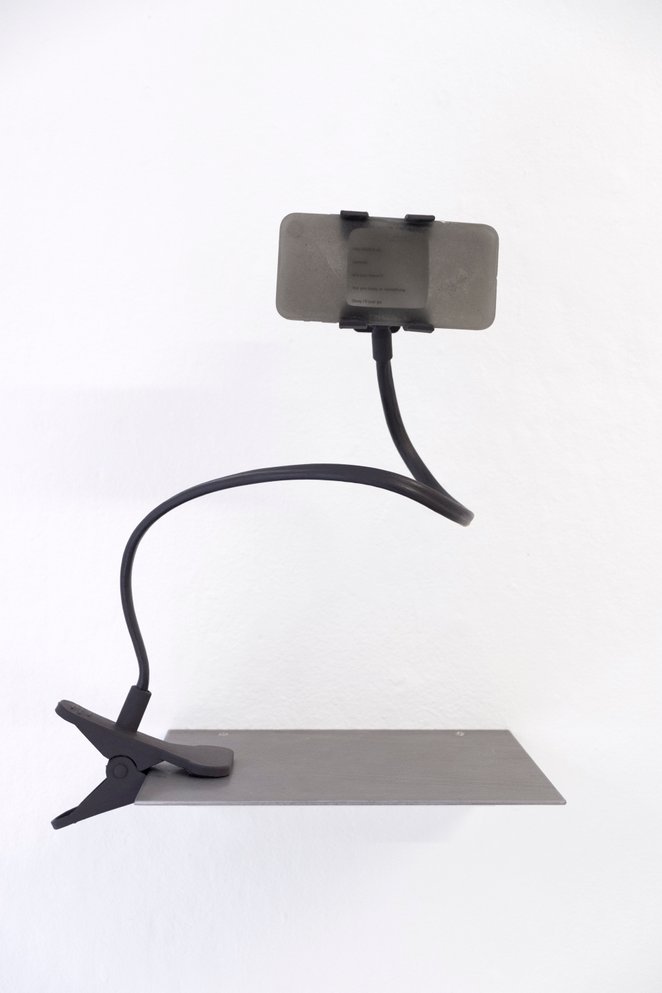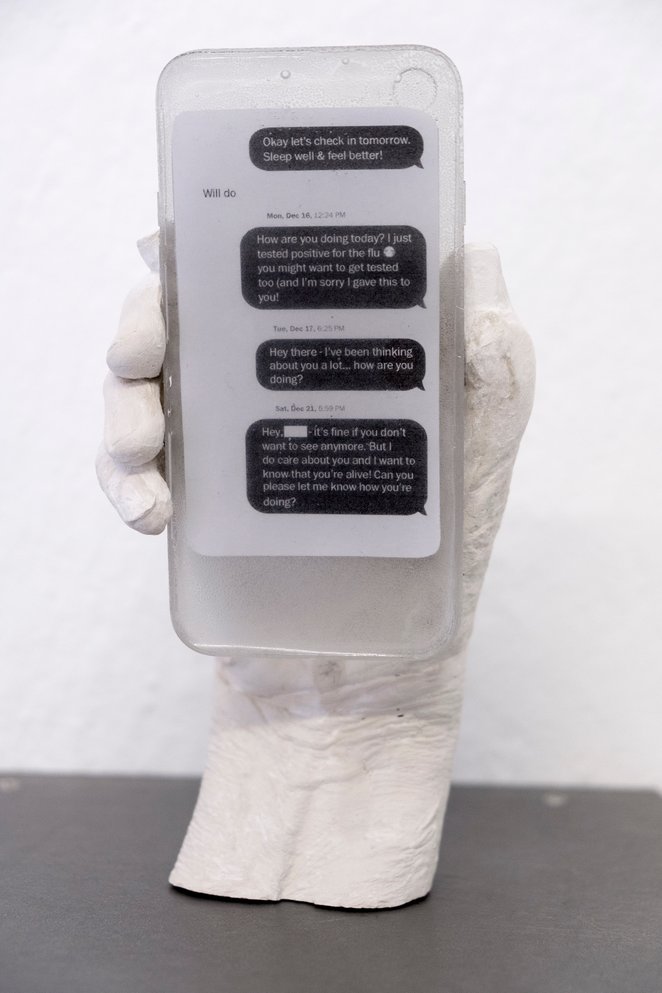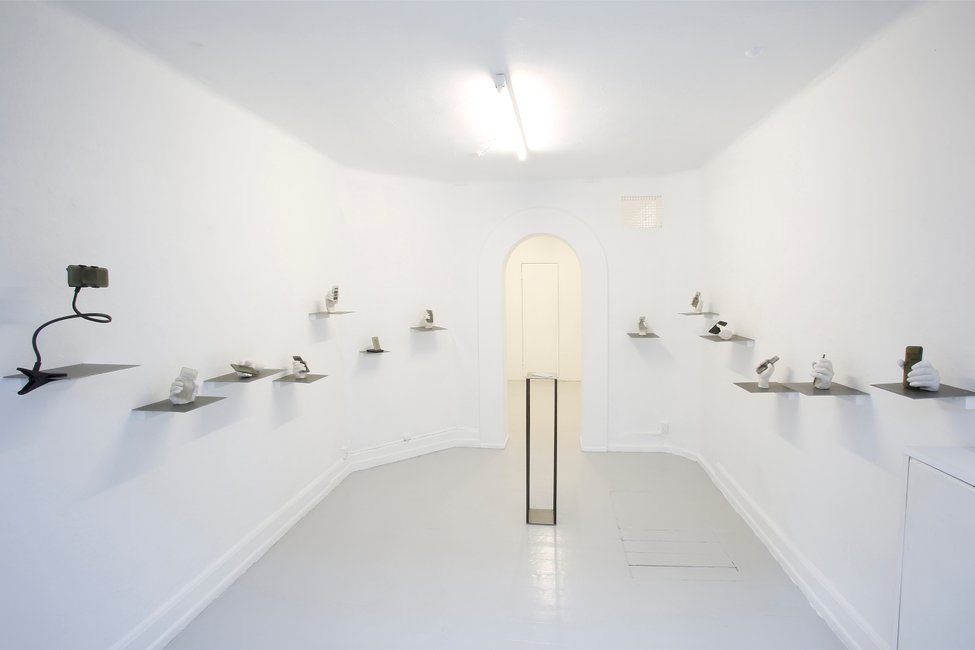© photo by Myne Søe-Pedersen
Installation view: Ghosting
Soloexhibition by Ida Retz Wessberg
Curated by Anne Munnecke
c4 projects, Copenhagen 03.11-08.12.2023
> Text written by curator and Art Historian Karen Vestergaard Andersen (scroll down)
> Press: IDOART
GHOST 02
2023
Isomalt casted smartphone with printed text (casted inside), plastercasted hand. Metal shelve. Unique.
H15 x L25 x W25 cm.
© photo by Camilla Reyman
GHOST 01
2023
Isomalt casted smartphone with printed text (casted inside), painted smartphone holder. Metal shelve. Unique.
H36 x L31 x W25 cm.
© photo by Camilla Reyman
GHOST 05
2023Isomalt casted smartphone with printed text (casted inside), plastercasted hand. Metal shelve. Unique.
H20 x L25 x W25 cm.
© photo by Camilla Reyman
Installation view
© photo by Camilla Reyman
Installation view
© photo by Myne Søe-Pedersen
Ghosting
Soloudstilling af Ida Retz Wessberg
Udstillingsstedet c4 projects, København
Kurateret af Anne Munnecke
03.11-08.12.2023
Tekst skrevet af kunsthistoriker og kurator Karen Vestergaard Andersen
(DK)
I Ida Retz Wessbergs soloudstilling på c4 projects undersøger hun onlinefænomenet “Ghosting”. Ghosting betegner en adfærd, hvor man undlader at svare eller opfører sig undvigende i en digital kommunikation med en romantisk, professionel eller anden platonisk relation. I materialer som luften i et stykke bobleplast, gips og sukker substituttet isomalt udforsker Retz Wessberg de gældende betingelser for denne adfærd gennem et fysisk forhold til teksten, dens sprog og tegn. På håndholdte smartphones og indkapslet i bobleplast kan vi for en stund læse uddrag af faktiske og forestillede korrespondancer og interaktioner, der er endt i ghosting. Værkernes materialer drager paralleller til både psykiske og fysiske tilstande af at være fastfrosset eller være ved at gå i opløsning. I dette tilfælde vil det klæbrige telefon-display, der består af isomalt, langsomt erodere ved iltning og blive ulæseligt i takt med at den fysiske forandring af materialet indtræffer.
I Retz Wessbergs hænder bliver materialets forgængelighed en vigtig bro til at nærstudere, hvor stærkt forbundne vores kroppe faktisk er i og til det digitale. Her peges på, at de kemiske stoffer f.eks. opioider som kroppen producerer i mødet med den savn, sorg og skam som afslag giver, på ingen måde adskiller sig fra andre reaktioner ved “fysiske” mødeformer. Værkerne berører i al deres klæbrige omskiftelighed, hvordan noget både kan være kropsligt og fjernt, åbenlyst og skjult på samme tid.
Som billedhugger er denne undersøgelse af fysiske og immaterielle egenskaber helt central for Retz Wessbergs praksis, der historisk og kritisk beskæftiger sig med sammenhængen mellem feminine narrativer, cirkularitet, kroppen og det forgængelige. I hendes vedvarende kunstneriske undersøgelse af den franske skulptør Camille Claudels (1864-1943) kunstnerskab, foretager Retz Wessberg på tværs af tid en art fremmaning af det, som er forblevet usynligt, udeladt og forglemt i kunsthistorien. I Ghosting er det således intet tilfælde at udstillingens hvide gipshænder fremstår som en mindre parafrase over ‘L’Abbatis' – det ‘bibliotek’ af gipsafstøbninger af modellerede hænder, arme og fødder, der var at finde i Auguste Rodins atelier, men som Camille Claudel var én af hovedkræfterne bag. I udstillingen er alle hænder også forskellige og hver figur er unik. Gipsen viser tydelige støbespor, og peger ikke ulig isomalten tilbage på processen, som en art evige forstadier.
I modsætning til de kønnede forestillinger og afgørende begrænsninger, der herskede på Claudels tid, fortsætter Retz Wessberg med at udfordre vores forståelse af de materielle og immaterielle realiteter, der definerer vores fælles samfund og dermed i høj grad påvirker kunstnerisk praksis. Denne kritiske stillingtagen ligger hele tiden og sitrer i værkerne, der gennem særligt de forgængelige materialers håndgribelige, men flygtige karakter søger at udforske det næsten ubegribelige.
Der var fire offentlige, gratis arrangementer i udstillingen:
Fernisering (3. november), Artist Talk med kunstneren og kunsthistoriker Karen Vestergaard Andersen (19. november), Workshop med Kunstneren (2. december) og Finnissage (8. december)
Udstillingen var generøst støttet af:
Statens Kunstfond, Augustinus Fonden, 15. Juni Fonden, Ny Carlsbergfondet, Aage og Johanne Luis-Hansens Fond, Københavns Kommune – Rådet for Visuel Kunst, Vesterbro Lokaludvalg – Lillepuljen, Dansk Tennis Fond og Billedkunstnernes Forbund
Tak!
/ (English version)
Ghosting
Solo exhibition by Ida Retz Wessberg
At the exhibitionspace c4 projects, Copenhagen
Curated by Anne Munnecke
03.11-08.12.2023
Text written by Art Historian and independent curator Karen Vestergaard Andersen
In Ida Retz Wessberg's solo exhibition at c4 projects, she examines the online phenomenon "Ghosting". Ghosting refers to a behavior where one fails to respond or behaves evasively in a digital communication with a romantic, professional or platonic relation.
In materials such as the air in a piece of bubble wrap, plaster and the sugar substitute isomalt, Retz Wessberg explores the prevailing conditions for this behavior through a physical relationship with the text, its language and signs. On hand-held smartphones and encased in bubble wrap, we can for a while read excerpts of actual and imagined correspondences and interactions that have ended in ghosting. The materials of the works draw parallels to both psychological and physical states of being frozen or about to disintegrate. In this case, the sticky phone display consisting of isomalt will slowly erode in contact with air and become unreadable as the physical change of the material occurs.
In Retz Wessberg's hands, the ephemeral material becomes an important bridge to closely study how strongly connected our bodies actually are in and to the digital. Here it is pointed out that the chemical substances e.g. opioids that the body produces in response to the loss, sadness and shame that this rejection causes, are in no way different from other reactions to "physical" encounters. The works, in all their sticky changeability, touch on how something can be both corporeal and distant, obvious and hidden at the same time.
As a sculptor, this investigation of physical and immaterial properties is absolutely central to Retz Wessberg's practice, which historically and critically deals with the connection between feminine narratives, circularity, the body and the impermanent. In her ongoing artistic investigation of the artistry of the French sculptor Camille Claudel (1864-1943), Retz Wessberg makes across time a sort of evocation of what has remained invisible, omitted and forgotten in art history. In Ghosting, it is by no means a coincidence that the exhibition's white plaster hands appear as a minor paraphrase of 'L’Abbatis' – the 'library' of plaster casts of modeled hands, arms and feet that were to be found in Auguste Rodin's studio, but which Claudel was one of the main forces behind. In the exhibition, all hands are also different and each figure is unique. The plaster shows clear casting marks, and thus not unlike the isomalt points back to the process, as a kind of eternal precursors.
In opposition to the gendered notions and decisive limitations that prevailed in Claudel's time, Retz Wessberg continues to challenge our understanding of the material and immaterial realities that define our common society and thus greatly influence artistic practice.This critical attitude is present at all times and vibrates in the works, which, especially through the tangible but fleeting nature of the perishable materials, seek to grapple with that which is almost unfathomable.
There was four public, free events in the exhibition:
Vernissage (3rd of November), Artist Talk with the artist and Art Historian Karen Vestergaard Andersen (19th of November), Workshop with the Artist (2nd of December) and Finnissage (8th of December)
The exhibition was kindly supported by:
Statens Kunstfond, Augustinus Fonden, 15. Juni Fonden, Ny Carlsbergfondet, Aage og Johanne Luis-Hansens Fond, Københavns Kommune – Rådet for Visuel Kunst, Vesterbro Lokaludvalg – Lillepuljen, Dansk Tennis Fond and Billedkunstnernes Forbund
Thank you!





